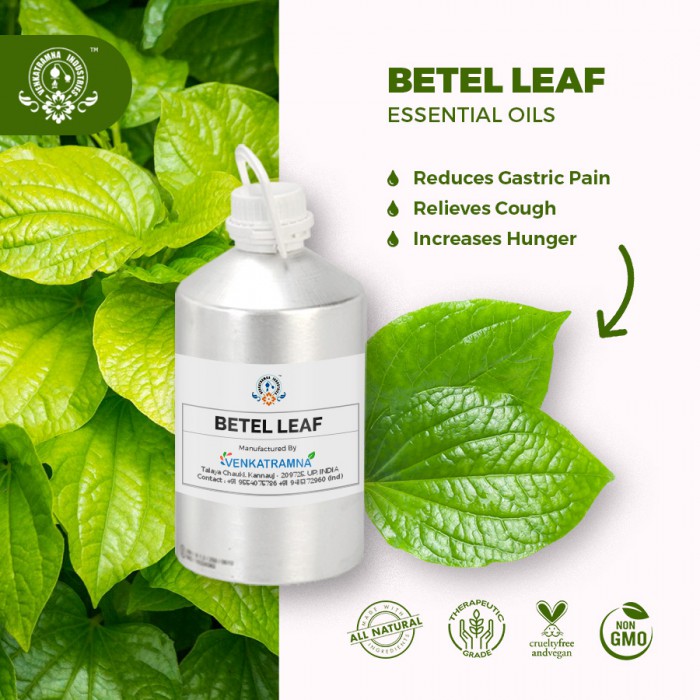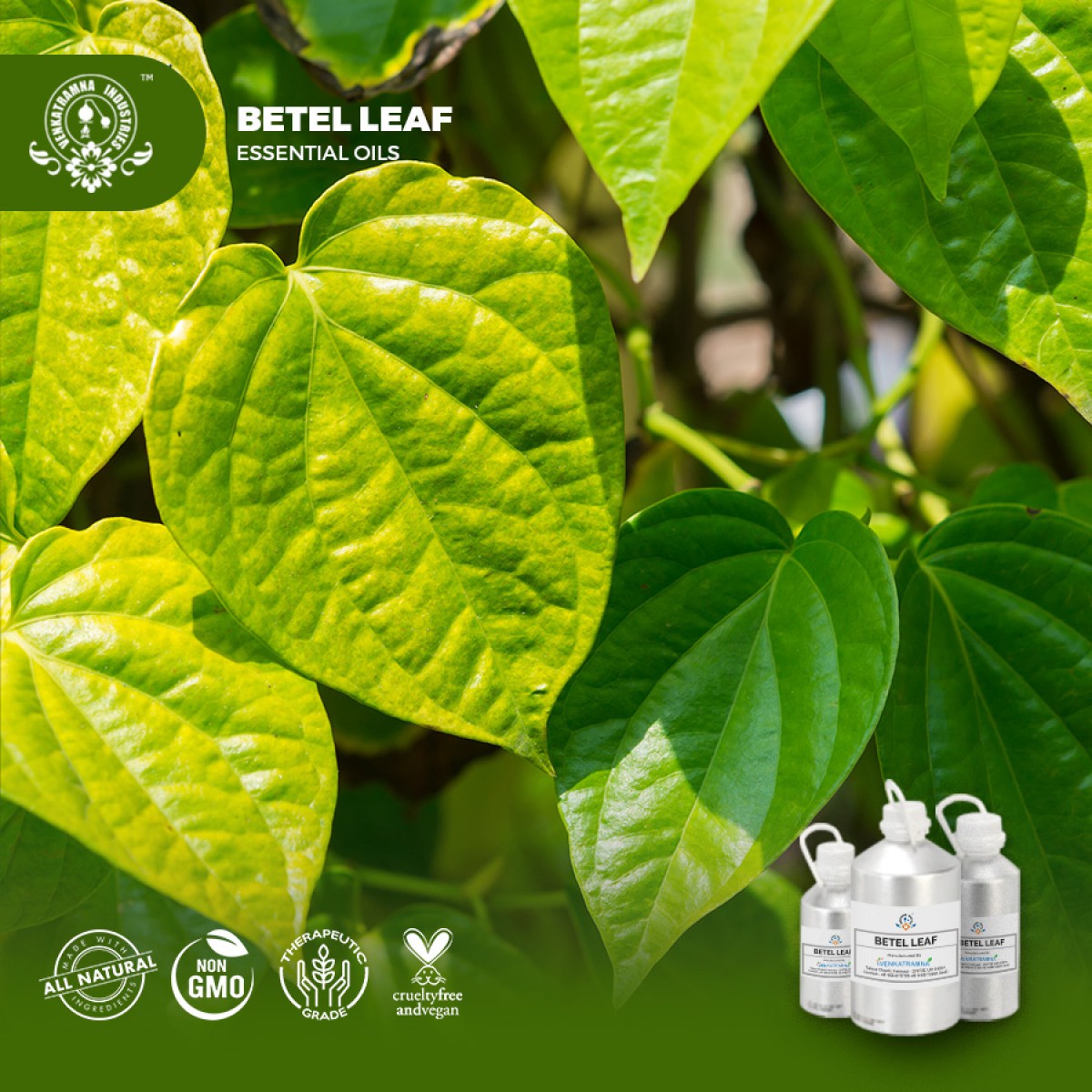Botanical Name: Piper betle Common name: Betel Plant family: Read More
|
Botanical Name: |
Piper betle |
|
Common name: |
Betel |
|
Plant family: |
Piperaceae |
|
Genus: |
Piper |
|
Appearance/Color: |
Yellow to dark brown liquid with
creosote- like odor. |
|
Odor: |
Distinctly phenolic, almost tar like or smoky. |
|
Blends With: |
Blends
with lavender, eucalyptus, tea tree, rosemary
and cardamom |
|
Origin |
India |
Betel leaf oil derived from betel leaf plant leaves that yield this aromatic essential oil. The heart-shaped leaves have distinct pleasant aroma and are commonly chewed alone or with other plant materials.
The betel which includes pepper and kava. Betel leaf is mostly consumed Asia, and elsewhere in the world by some Asian emigrants, as betel quid or in paan with Areca nut and/or tobacco.
In Sri Lanka and in many parts of India a sheaf of betel leaves is traditionally offered as a mark of respect and auspicious beginnings. Occasions includes, greeting elders at weeding ceremonies, New Year, offering payment to Ayurvedic physicians and astrologers where usually money and/or areca nut are kept on top of the sheaf of leaves and offered to the elders for their blessings.
The betel leaf is cultivated mostly in India farmers called barouj prepare a garden called a barouj in which to grow betel. the barouj is fenced with bamboo sticks and coconut leaves. The soil is plowed into furrows of 10 to 15 meters’ length, 75 centimeters in width and 75 centimeters’ depth. Oil cakes manure, and leaves are thoroughly incorporated with the topsoil of the furrows and wood ash. The cutting is planted at the beginning of the monsoon season.
The complete range of conditions or methods of use are beyond our control therefore we do not assume any responsibility and expressly disclaim any liability for any use of this product. Information contained herein is believed to be true and accurate however, all statements or suggestions are made without warranty, expressed or implied, regarding accuracy of the information, the hazards connected with the use of the material or the results to be obtained from the use thereof. Compliance with all applicable federal, state, and local laws and local regulations remains the responsibility of the user.
The FDA has not evaluated the statements on this website. No claims are made by Venkatramna Industries as to the medicinal value of any products from vriaroma.com or by us. The information presented here is for educating our customers about the traditional uses of essential oils and is not intended to diagnose, treat, cure, or prevent any disease. You are responsible for understanding the safe application of these products. If you have any questions, please call or email us for further information.
As per NAHA guidelines, New Directions Aromatics (NDA) does not recommend the ingestion of essential oils. It is imperative to consult a medical practitioner before using Essential Oils for therapeutic purposes. Pregnant and nursing women and those taking prescription drugs are especially advised not to use this product without the medical advice of a physician. The oil should always be stored in an area that is inaccessible to children, especially those under the age of 7.
The essential oil has various medicinal properties due to which it is highly demanded in the pharma and ayurvedic industries. It has antiseptic properties due to which it is used in many pharma and ayurvedic products.
The betel leaf essential oil is valued in Ayurveda for its stimulating, carminative, aromatic, antiseptic, warming and aphrodisiac properties. It has several medicinal applications among natives and is especially used to harden gums, preserve teeth and sweeten breath. It also improves voice and reputed aphrodisiac.
It has invigorating properties and the oil is also used as a deodorant component.
Ingredients:
|
S.No |
Key Constituents |
Strength (%) |
|
1 |
Safrole |
6.5-45.3 |
|
2 |
Eugenol |
20.5-33.2 |
|
3 |
a-Terpinyl acetate |
6.8-11.0 |
|
4 |
Isoeugenol |
0-10.6 |
|
5 |
(E)-Anethole |
0-7.8 |
|
6 |
b-Caryophyllene |
0-7.8 |
|
7 |
Dodecanal |
0-7.1 |
|
8 |
b-Selinene |
0-6.4 |
|
9 |
Sabinene |
0-6.1 |
|
10 |
Estragole |
0-4.8 |
|
11 |
a-Cubebene |
0-4.4 |
|
12 |
Camphene |
0-3.7 |
|
13 |
a-pinene |
0-3.2 |
|
14 |
Decanal |
0-2.9 |
|
15 |
1,8-Cineole |
0-2.8 |
|
16 |
0ctadecanal |
0-2.7 |
|
17 |
b-Elemene |
0-2.6 |
|
18 |
Geraniol |
0-2.5 |
|
19 |
a-terpineol |
0.3-2.3 |
|
20 |
b-myrcene |
0-2.2 |
|
21 |
a-thujene |
0-1.9 |
|
22 |
g-elemene |
0.9-1.8 |
|
23 |
Methyleugenol |
0.3-1.7 |
|
24 |
g-terpinene |
0.5-1.6 |
|
25 |
Caryophyllene |
0-1.6 |
|
26 |
linalool |
0.2-1.5 |
|
27 |
Terpinen-ol |
0-1.5 |
|
28 |
b-phellandrene |
0-1.3 |
|
29 |
Bornylene |
0-1.2 |
|
30 |
d-cadinene |
0-1.2 |
|
31 |
a-muurolol |
0-1.2 |
|
32 |
g-cadinene |
0-1.1 |
Dilute before use; for external use only. May cause skin irritation in some individuals; a skin test is recommended prior to use. Contact with eyes should be avoided.
Safety summary
Safety Advice
Organ-specific effects
Systemic effects





 MSDS-Betel_Leaf.pdf
MSDS-Betel_Leaf.pdf




